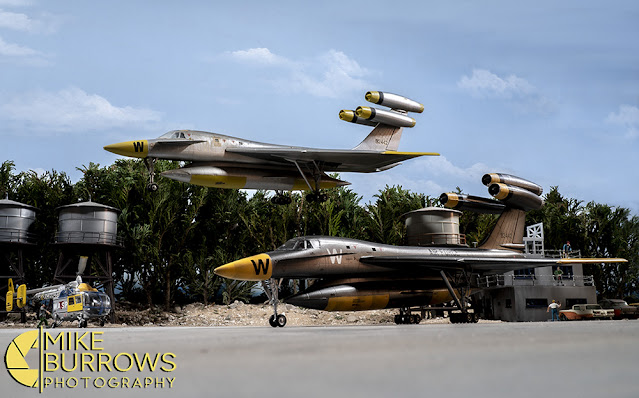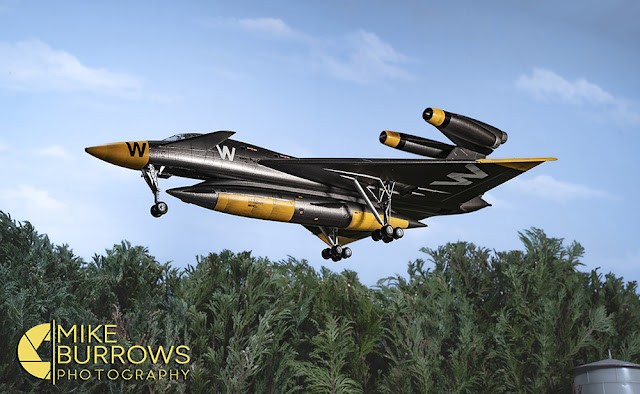Some photos of my WASP ‘Spearhead’ bomber, as seen in Gerry & Sylvia Anderson’s TV series, Stingray.
The model is a fairly simple build and uses a 1:72 scale Italeri Convair B-58 Hustler kit, which needs little alteration. Of course, the most obvious change is 3 of it’s 4 turbojet engines are attached to the tail fin rather than the wings, along with the addition of a couple of forward canards made from plastic card. There are a couple of subtle changes; The fins on the under fuselage weapons pod needed to be repositioned, and I left the plastic glass out of the rear cockpit windows. When the landing gear is fitted, the fold down doors are left off.
The position of the engines, often a point of debate for the more pedantic aircraft enthusiasts who forget it’s fictional, means the model needs to be weighted towards the front, otherwise it will just tip back.
I added a large ‘W’ under the starboard wing. I can’t say for sure whether the filming props had that, as my screen captures of the aircraft viewed from below showed something that could be a ‘w’, but wasn’t at all clear. Nevertheless, I like the look. I’ve noted some modellers have also added a large’ W’ on top of the port wing, but I decided against that.
The model is painted in Hycote gunmetal, and Revell matt yellow, followed by some light weathering. After applying the Letraset lettering and some of the supplied decals, the model was finally sprayed with a matt sealer.
I did make a Spearhead bomber using a similar kit, some 35 years ago, when my reference material was a bit thin on the ground. I sprayed that one silver, and for the yellow detailing I used pale matt yellow enamel paint.
The original studio models were made from Aurora 1:76 scale Hustler kits. As these are long out of production, the Italeri kit is a cheaper and much easier to find alternative.
I'm told that they may have also used Revell and Lindberg kits, too.
Around a dozen Spearhead models were produced for Stingray, some in flying mode and some with landing gear fitted.
The models were built by studio model makers, Richard “Eric” Backman, and Ezra Dearing (born William Jones). Both worked on several of the Anderson’s productions. Eric had already worked on the Anderson’s previous puppet series, Fireball XL5. Ezra was in his mid fifties when he worked on Stingray, making him one of the oldest people to have worked for the studio.
In the series the Spearhead jet squadrons are used as multi-task aircraft. Apart from their main role as a vertical take-off jet bombers, they can double as V.I.P. passenger transporters, as well as able to participate in search and rescue operations.
As they are seen in the opening titles, the Spearhead jet squadron appear in every episode of Stingray. They feature in the opening episode story as aerial search aircraft.
In ‘Emergency Marineville’ two Spearhead aircraft bomb Baul Island, a base used by undersea aliens, Nucella and Chidora, who have launched several surprise missile attacks on Marineville.
In ‘Pink Ice’, a Spearhead bomber, complete with a WASP Arrowhead fighter escort is used to transport Comr. Shore from WASP HQ in Washington back to Marineville.
In ‘A Nut for Marineville’, the eccentric Professor Burgoyne is tasked to develop a new nosecone for Stingray’s sting-missiles, and is flown to Marineville aboard an executive Spearhead bomber.
Using the Convair B-58 Hustler, as a basis for the WASP Bomber was arguably, a good choice. It was without doubt, a sleek, and capable looking aircraft, very advanced and had not long entered operational service as a state-of-the-art Nuclear bomber when Stingray was being produced.
The B-58 was the fastest bomber at that time, capable of Mach 2 (1375 mph) at high altitude, and had a range of 5115 miles, combining fuel from it’s internal and it’s under-fuselage fuel pod.
It could fly for up to 18 hours carrying a payload of up to six nuclear weapons to any target on the globe.
B-58 Hustlers appear as fictitious ‘Vindicator’ bombers in the 1964 Cold War thriller, Fail Safe, and later, the 2000 made-for-TV remake.
It was, however a difficult aircraft to fly, and cost a fortune to maintain. It entered service during March, 1960, and was retired just ten years later, in January, 1970.
https://mikeburrowsphotography.co.uk/











What a beautiful recreation of an iconic Supermarionation craft! That old Hustler never looked better! SFZ
ReplyDeleteThanks Zigg. It's certainly a great looking jet. Hustler kits of various scales, and parts of them turned up quite regularly in Anderson shows. One memoriable example is as a supersonic airliner in the Fireball XL5 episode, Space City Special. The kit is thinly disguised by placing the engines on top of the wings instead of underneath!
DeleteLovely stuff Scoop.
ReplyDeleteCheers Mish. Making models and thinking up dioramas is always a great way to help improve my photography.
DeleteWhat a great info filled post!
ReplyDeleteYour models are great, and as a topper, I see the background Control tower is actually an Airfix RAF type!
I'm probably going to have to build one of those for my project!
Thanks Lewis. I'm glad you spotted and mentioned the old Airfix RAF tower, you certainly know your old Airfix kits. The kit does actually appear as airfield background dressing in Stingray. (Along with the Heller water towers) It's another one of those kits that turn up in other Anderson shows. I suppose the old Girder bridge is probably the most overused one, though.
DeleteLovely models and photos Scoop. Could be from Century 21 those! They'll be ringing you! Congrats on your site too.
ReplyDeleteCheers Woodsy. My website is still slowly evolving, but it's just an easier way for people to find my photos on the Internet.
DeleteSuperior build and photos Scoop! I luv the re-purposing/re-imagineering of existing hardware the Anderson team did and these photos bring that to life in an amazing way!!
ReplyDeleteI spend my time trying to track down the original kits they used, Ed. I find them very nostalgic.
Delete